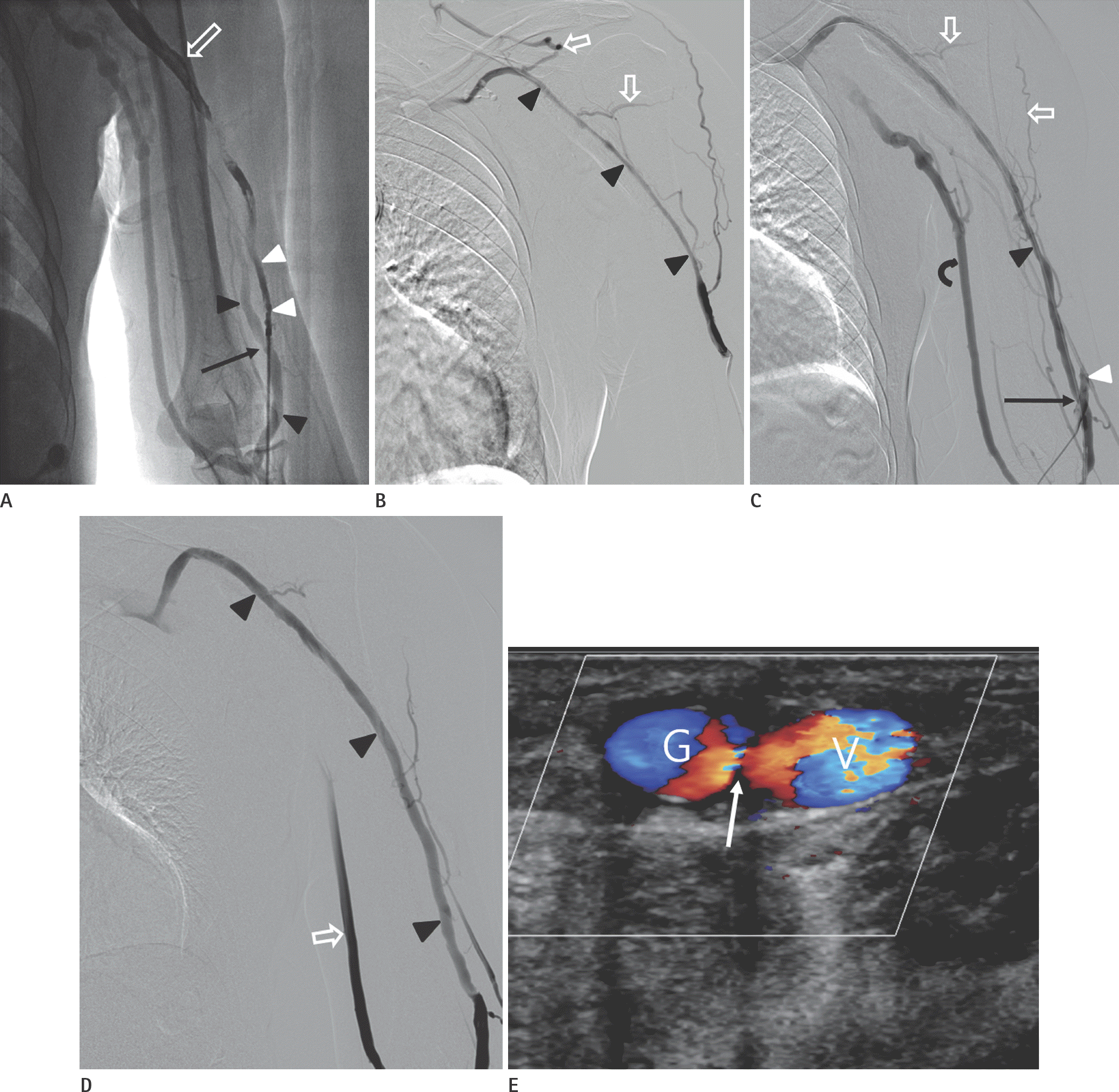Abstract
An iatrogenic graft-to-vein fistula that develops between a vascular access graft and an adjacent vein is a rare but significant complication. We report a case of an arteriovenous hemodialysis graft (AVG) with an iatrogenic graft-to-vein fistula and a thrombosed venous limb. The AVG was preserved and used for hemodialysis through the fistula and the cephalic vein. The thrombus in the venous limb could not be removed.
REFERENCES
1.Min SK., Park YH., Lee HH., Lee JS., Chung WK., Lee JH, et al. Iatrogenic fistula between prosthetic haemodialysis access graft and autogenous vein: unusual cause of graft throm-bosis. Nephrol Dial Transplant. 2004. 19:2647–2649.

2.Haddad NJ., Vachharajani TJ., Van Cleef S., Agarwal AK. Iatro-genic graft to vein fistula (GVF) formation associated with synthetic arteriovenous grafts. Semin Dial. 2010. 23:643–647.

3.Margoles HR., Shlansky-Goldberg RD., Soulen MC., Trerotola SO. A proposed management algorithm for fistulae between hemodialysis access circuits and adjacent veins. J Vasc Ac-cess. 2012. 13:374–380.
4.Hwang JK., Moon IS., Kim JI. Vascular access graft thrombo-sis by iatrogenic fistula. Dialysis & Transplantation. 2010. 39:214–215.

5.Kanterman RY., Vesely TM. Graft-to-vein fistulas associated with polytetrafluoroethylene dialysis grafts: diagnosis and clinical significance. J Vasc Interv Radiol. 1995. 6:267–271.

6.Standage BA., Schuman ES., Quinn SF., Ragsdale JW., Sheley RC. Single limb patency of polytetrafluoroethylene dialysis loop grafts maintained by traumatic fistulization. Ann Vasc Surg. 1998. 12:364–369.

7.van Kempen BP., Smits HF., Blankestijn PJ. Haemodialysis ac-cess graft with shunting through an iatrogenic fistula--the diagnostic role of magnetic resonance flow measurement. Nephrol Dial Transplant. 1999. 14:444–446.
Fig. 1.
Fistulography in a 77-year-old male with end-stage renal disease. A. Fistulography via the arterial limb of graft shows a fistula (black arrow) between the arterial limb of the graft (white arrowheads) and an adja-cent native cephalic vein (black arrowheads) of left upper arm. Contrast material (empty arrow) leaked and spread out around the cephalic vein through the cannulation site of venous limb of the graft. B. Fistulography via the native cephalic vein shows diffuse stenosis in cephalic vein (black arrowheads) and collateral veins (empty arrows). C. Fistulography via the arterial limb of the graft (white arrowhead) after balloon angioplasty of the cephalic vein stenosis shows residual steno-sis in the cephalic vein (black arrowhead) and graft-to-vein fistula (black arrow) with some residual collateral veins (empty arrows). Basilic vein (curved arrow) is visualized by communication with the antecubital vein draining into the cephalic vein. D. Fistulography after balloon dilatation of cephalic vein revealed the disappearance of the stenosis in the cephalic vein (black arrowheads) and markedly decreased collateral vessels. Basilic vein (empty arrow) is visualized by communication with the antecubital vein draining into the ce-phalic vein. E. Doppler study of the arteriovenous hemodialysis graft after the procedure shows a graft-to-vein fistula between arterial limb of the graft and native cephalic vein (arrow). G = arterial limb of the graft, V = cephalic vein

Table 1.
Demographics and Characteristics of Patients with Graft-to-Vein Fistula in AVF and AVG (n = 34)




 PDF
PDF ePub
ePub Citation
Citation Print
Print


 XML Download
XML Download